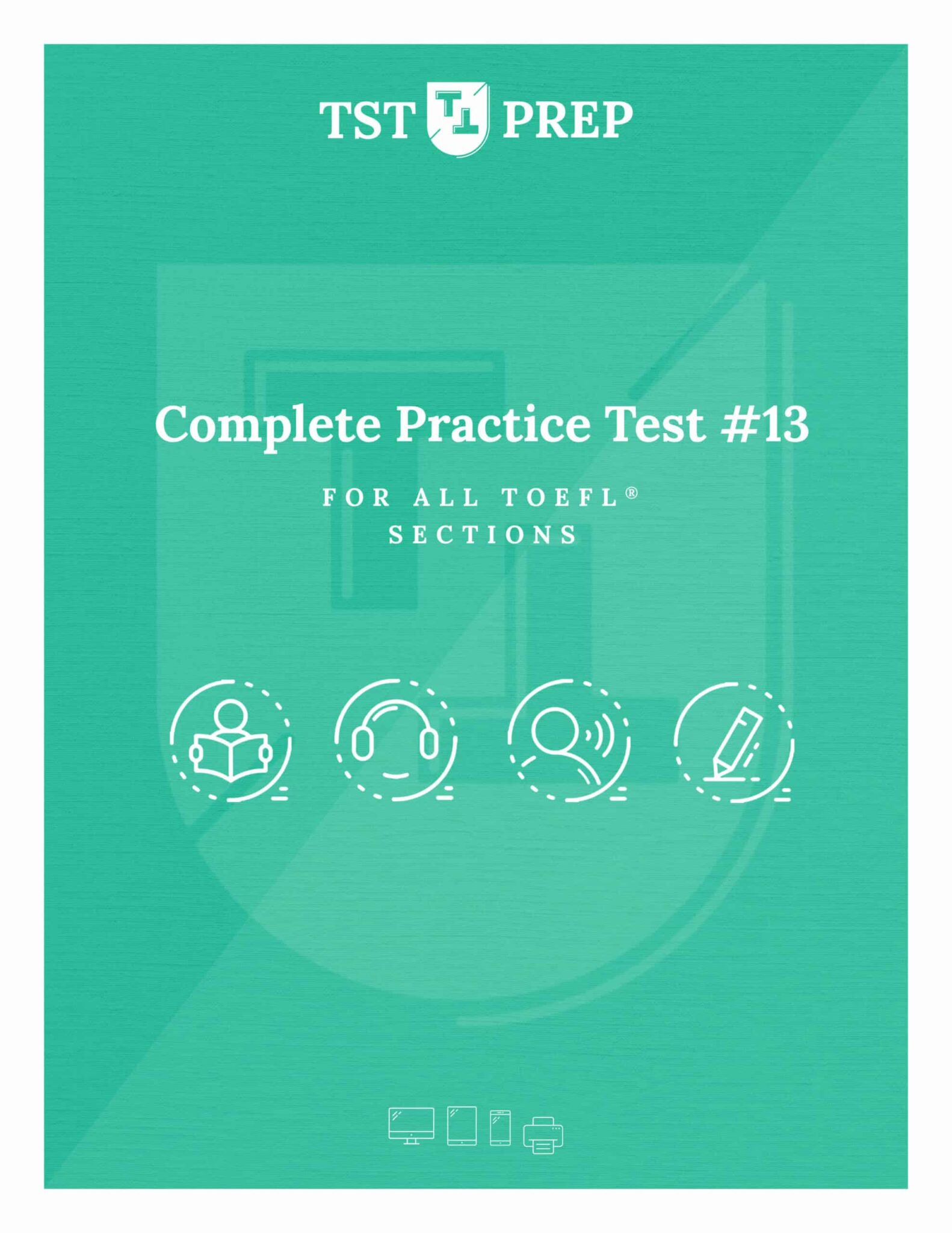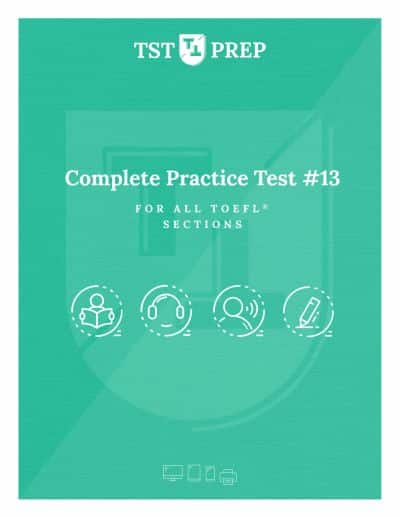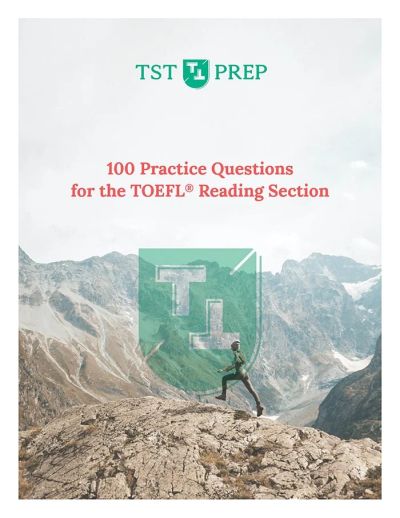EN | PT
Free Practice Test for the TOEFL® (PDF)
Ready to download the PDF version of your complete TOEFL sample test?
Well here it is: Complete Practice Test #13 so you can know what to expect on test day.
Or are you looking for Practice Questions for the TOEFL® Reading?
Well, we have 100 of those for free right here. 100 Practice Questions for the TOEFL® Reading Section
But wait!
Getting a complete TOEFL practice test is only half the battle.You also need to learn the structure of the test and how to study effectively.
Here is the TOEFL Exam structure and some helpful tips
- Tip #1: Get used to the clock
- Tip #2: Type without spellcheck
- Tip #3: Take notes like a TOEFL pro
- Tip #4: Study like an American!
- Tip #5: Prepare for a noisy TOEFL iBT Test
The TOEFL Reading Section
The first part of the exam is the TOEFL Reading section. As of the latest TOEFL update on July 26, 2023, there are two academic passages of approximately 700 words each. The subjects will consist of texts found in a typical university textbook. Following each passage are ten questions about the reading passage. You will have 36 minutes to read the two passages and answer the 20 questions in total.
There are ten types of questions in the Reading section of the TOEFL. The frequency of each question type varies. Here is a helpful chart of the question types with examples of the question phrasing.
The Reading Section Question Types
| Question Type | Frequency | Time to Answer | Question Value | Question Phrasing |
| 1. Vocabulary | 2-4 | 60 seconds | 1 | “The word _________ in paragraph 2 is closest in meaning to…” |
| 2. Factual Information (Detail) | 3-6 | 90 seconds | 1 | “According to paragraph 4, what….” “Which of the following…” “It is stated in paragraph 4 that…” |
| 3. Negative Factual Information (Negative Detail) | 2-4 | 120 seconds | 1 | “All of the following are mentioned in paragraph 3 EXCEPT…” “Which of the following is NOT mentioned….” |
| 4. Inference | 2-4 | 90 seconds | 1 | “What can be inferred from paragraph 5 about…” “Paragraph 5 implies that…” “Paragraph 5 suggests…” |
| 5. Rhetorical Purpose (Author’s Purpose) | 2-4 | 90 seconds | 1 | “In paragraph 6, the author discusses ________ in order to…” “Why does the author mention…” |
| 6. Sentence Simplification (Paraphrasing) | 2-3 | 120 seconds | 1 | “Which of the sentences below best expresses the essential information in the highlighted sentence in paragraph 4?” |
| 7. Insert Text (Sentence Insertion) | 2-3 | 120 seconds | 1 | “In paragraph 2 there is a missing sentence. Where would the sentence best fit?” |
| 8. Reference (Pronoun Referent) | 0-1 | 60 seconds | 1 | “The word _________ in paragraph 1 refers to…” |
| 9. Prose Summary (Summary) | 1-2 | 150 seconds | 1 | “An introductory sentence for a brief summary of the passage is provided below. Complete the summary by selecting the THREE answer choices that express the most important ideas in the passage.” |
| 10. Fill In A Table (Organization) | 0-1 | 150 seconds | 2-3 | “Complete the table below to summarize information about _________ in the passage. Match the appropriate statements to _________” |
For more information about the TOEFL Reading section, check out this post by Professional ESL Test Prep
The TOEFL Listening Section
After the Reading section, you will have to complete the Listening section, which will take about 36 minutes. The Listening section is divided into two identical parts. In each part, you will have three listening passages: one conversation between a student and campus employee and two academic lectures. The conversations last 2-4 minutes, and the academic lectures are approximately five minutes each.
You will be asked five questions after the conversation, ten in total, and six questions after each of the four academic lectures, 24 in total. The question types, like in the Reading section, vary. This chart explains the question types, with examples of phrasing, and the frequency of the question type:
The Listening Section Question Types
| Question Type | Question Frequency (per section) | Question Value | Question Phrasing |
| 1. gist – content | 3-5 | 1 | “What is the topic of the discussion?” “What is the professor mainly discussing?” |
| 2. gist – purpose | 1-2 | 1 | “Why does the student visit the professor?” “Why does the professor mention…?” |
| 3. detail | 6-10 | 1 | “What is stated in the passage about…” “According to the speaker,…” |
| 4. understanding the speaker’s attitude | 1-4 | 1 | “What’s the professor’s opinion of…?” “What can be inferred about the student?” |
| 5. understanding the function | 3-6 | 1 | “What does the speaker mean when he says…” “Why does the professor say this…” |
| 6. making inferences | 1-4 | 1 | “What can be inferred about …?” “What does the speaker imply about…?” |
| 7. understanding organization | 2-5 | 1 | “How does the professor organize the information about…” |
| 8. connecting content | 1-4 | 2 | This is a question where you must fill out a table and indicate the correct information. “What does the professor imply about X?” |
There used to be a 10-minute break during the TOEFL test but not anymore. As of July 26, 2023, the TOEFL test was shortened to take just two hours to complete, and the break time was retired.
The TOEFL Speaking Section
After the listening comes the TOEFL Speaking section. The structure of this section is different from the reading and listening. In the speaking section, you will encounter four questions. The first is an independent question, and the next three are integrated questions. Let’s take a closer look at each since they all follow a different structure.
The first question is usually a paired-choice question, which means you must decide between two choices. For example:
“Do you agree or disagree: all high school students should wear school uniforms.”
The questions range in subject matter, so there is no way to prepare a specific answer before the exam. You might be asked a question about business, travel, education, family, friendship, and so on. After the question is asked, you will be given 15 seconds to prepare a response and 45 seconds to speak.
Question two is the first of three integrated speaking questions. This is probably the easiest of all the integrated speaking questions.
First, you will read a short announcement about a new rule or policy on campus. Like question two, question three will begin with a short reading passage.
In task four, you are expected to listen to an academic topic for two to three minutes and then report on the information you heard. You will be given 20 seconds to prepare and 60 seconds to speak. In your response, you must be able to identify the topic of the lecture and the most important details.
The Speaking Section Question Types
| Question Type | Question Details | Question Explanation | Time Breakdown |
| Independent Speaking | Question 1 Paired Choice | Asks about your general opinion on a wide range of possible issues. You usually have just two options. | 15 seconds to prepare 45 seconds to speak |
| Integrated Speaking | Question 2 Campus Announcement and Conversation | Report on the opinion of one of the speakers in the conversation and explain why he or she feels that way | 50 seconds to read/take notes 60-120 seconds to listen/take notes 30 seconds to prepare 60 seconds to speak |
| Question 3 Academic Reading and Lecture | Explain the academic topic introduced in the reading and describe the main points about the topic described in the lecture. | 45 seconds to read/take notes 60-120 seconds to listen/take notes 30 seconds to prepare 60 seconds to speak | |
| Question 4 Academic Lecture | Sum up the topic and main points from the lecture. | 120-180 seconds to listen/take notes 20 seconds to prepare 60 seconds to speak |
The TOEFL Writing Section
Finally, you have arrived at the last section, the TOEFL Writing section. The Writing section lasts about 30 minutes. Here, you will be expected to write an essay in response to two separate writing tasks.
The first is an integrated writing task, and the second is called Writing for an Academic Discussion. The integrated writing is almost identical to question #4 in the TOEFL Speaking section. You will read a passage, listen to a lecture, and then write about the two.
The last question on the exam was introduced on July 26, 2023, Writing for an Academic Discussion. You will be asked to contribute to an online discussion where a professor will pose a question, and two students offer their opinions. You will be expected to write at least 100 words that contribute to the discussion. Check out an example below:

Here is a breakdown of the tasks and the time allocations for the TOEFL Writing section:
The Writing Section Question Types
| Question Type | Question Details | Question Explanation | Time Breakdown |
| Integrated Essay | 1. Read an academic text 2. Listen to a lecture 3. Write your essay | Connect the topic of the reading with the academic lecture. Show how the main points in the reading are contrasted by the lecturer. Only report on the information you heard and read | 3 minutes to read/take notes 2-3 minutes to listen/take notes 20 minutes to write |
| Writing for an Academic Discussion | 1. Read a topic introduction and question by professor 2. Read two student responses to the question 3. Write your response | Write a response that adds to the discussion. Be sure to answer the question. You may cite some of the points made by other students, but it is not necessary. Aim to write at least 120 words. | 10 minutes to read and write |
Five Tips to Improve your TOEFL Score!
Here are five actions you must take while studying for the TOEFL so you can improve your score.
TIP 1: Get Used to the Clock
This is a timed iBT test! And, each section of the TOEFL lasts somewhere between 30 minutes to an hour. Therefore, it is very important to get used to working with the clock.
When studying at home, ALWAYS do practice tests under the test time constraints. This will prepare you to work under pressure and manage your time on test day. See the time breakdowns above for each section of the exam.
TIP 2: Type Without Spellcheck
On the TOEFL exam, you will not have access to spellcheck. Therefore, you should be practicing with spellcheck turned off! You are going to be responsible for finding your own grammar, spelling, and punctuation mistakes on test day, so start practicing this now!

This is especially true for the Writing section, where you will be writing essays. Give yourself extra time to edit and proofread your answers since you won’t have spellcheck there to do it for you.
TIP 3: Take Notes Like a TOEFL pro
Throughout the test, one of the most important things to do is to take notes! You will need to give yourself a little extra time to gather your thoughts and plan your answers. So, during the exam, you need to take good notes. Therefore, you should practice taking notes on your practice tests too.
I can’t emphasize this enough.
Note taking is important for EVERY section of the exam!
TIP 4: Study like an American!

As you prepare for the TOEFL, you should do a lot of TOEFL practice tests. Grading the TOEFL Reading and Listening sections of the exam is easy, but the speaking and writing sections will require professional help from a teacher or TOEFL expert.
Don’t make the same mistake as others. You need someone who knows about the TOEFL to listen to your speaking and read your writing responses. They will tell you your strengths, weaknesses and exactly what you need to do to improve.
If you just download the free TOEFL practice PDF without asking someone to grade your speaking and writing, then you are NOT putting yourself in a position to improve.
That’s why there are certified English teachers out there who are available to give you feedback on your practice exams, especially for the Speaking and Writing sections. Reach out to them to get the help you need while preparing for the TOEFL.
TIP 5: Prepare for a noisy TOEFL Test
Be prepared for a noisy room on test day. At the test center, you will hear the voices of other students because everyone will be responding to the speaking section questions at different times.
There will also be noise from people dropping their pencils, coughing, opening, and closing doors, etc. Trust us, it is not going to be ideal for test-taking.

So, in order to simulate this kind of test environment, take your complete TOEFL iBT practice tests in a coffee shop or in another, louder area. That way, you will already know how to ignore these kinds of distractions on test day!
Look, we know the TOEFL exam is a huge undertaking, and kudos to you for taking it on! If you feel like you want more help, Sojourning Scholar also made a list of the Best TOEFL YouTube Channels in 2025 where you can find additional helpful materials.
The fastest and easiest way to your TOEFL score is through practice.
Use this free test to get started:
Complete Practice Test #13
Did you find these TOEFL tips helpful?
Is there another TOEFL tip you believe is useful?
Let us know in the comments section below.
And we are always here to help if you have any questions: contact@tstprep.com












134 Comments
Peak Academy
Best Introduction regarding basic four sections of TOEFL test.
Keep It Up ….!
Josh
Wow! Nice compliment and much appreciated Peak Academy. We will keep working. Let me know if there’s anything you would like to see in particular.
Binyam Ayele
Hi josh first I want to thanks you for your support my question is how can I contact you on social media to be in touch and ask questions like on face book or telegram and my other question is how can I douloud all sections of tofle practice tests
Josh
Hi Binyam and thanks for asking. I try to respond to comments on our TST Prep (like right now) and on Youtube – https://www.youtube.com/toeflspeakingteacher1.
We also have a support staff that you can always reach out to at contact@tstprep.com.
Hope that answers your question.
John
This is so valuable – a great breakdown of the exam from one of the best in the business! Thank you Josh!
Josh
Ha, thank you John. I do really appreciate that 😉
Tanya
thank you 🙂
Leonardo
Thank you so much for these materials, they were a life saver !!
Josh
That’s great to hear Leonardo! Let me know if there’s any other way we can help 😉
Najibullah Naziry
So practical thank you so much.
Josh
Thank you for the kind comment 🙂 It really helps us when students like you confirm the quality of our materials. Thanks again!
Suncana
Some of the information on this website is contrary to the official toefl book info, especially regarding the number of words in written parts, which cofuses me. Why’s that?
Josh
Excellent point Suncana. There’s an excellent and short article about this issue on TOEFL Resources at this link – https://www.toeflresources.com/news/question-how-long-should-a-toefl-essay-be – but here is a short quote which I believe answers your question,
“I am often asked how long the TOEFL essays should be. The quick answer to this is that an independent essay should be between 380 and 400 words, while an integrated essay should be between 280 and 300 words.Let me explain where these numbers come from. It is true that when you are looking at the screen at the test center, the TOEFL software will suggest that a “typical” essay is much shorter than what I have suggested above. I caution you that a “typical” essay should not be your target. A typical essay will score in the low twenties. If you want a higher score than that, you need to write more.” – Hope that helps!
Suncana
Thank you very much. I really appreciate your help
Best regards
Josh
No problem! 😉
Kelly
This test is such a practical 🙂 Also, i bought test packs so I can practice it everyday until my exam date. Thank u!
Josh
Thank you for your trust and support Kelly! I appreciate it. Don’t hesitate to let me know if you have any questions.
Azode Elvis
I really enjoy having this test because it brings out aspiration and motivation so I which to summit all my efforts to go far
Josh
That’s great! Good luck and let me know if you have any questions along the way.
Mohammed Almisbahy
Hi sir ….
I’m really appreciated that you allow us to understand the way of the test .
I wish you all the best
Josh
Thank you for your kind words! Happy to help 🙂
Joseph
I really appreciate this plateform, looks so practical, but i need your help to improve my speaking and writting.
Josh
Hi Joseph and I understand what you mean. Some students need more personalized feedback, especially for speaking and writing. If you check the TOEFL store you will see classes and evaluations for the speaking and writing. You might consider enrolling.
https://tstprep.com/toefl-store/
Either way, happy to hear you found the site helpful.
Josh
You’re welcome 🙂
Gulnar Albushova
Mr. Josh,
This website is perfect!!! After the superlearn.com shut down I felt hopeless about TOEFL. Thank you very much for regaining my hope again.
I am advertising your website everywhere!
Best of luck!
Josh
Wow, thank you for your kind words Gulnar. And we are new so spreading the word would be great. Let me know if there is any other way we can help.
Tamiris
This website is really helpful! I have been practicing a lot for my TOEFL test these days and this preparation will help me improve in Writing and Speaking section.
Nice job! Congratulations to the team.
Josh
Thank you for your kind words Tamiris. Let me know if there is anything else we can do to help.
Paola Merizalde
Hi Josh, I really appreciate the big efforts from you and your team in the success of the Toefl students. I have a question for you. It seems almost impossible to read the passages of the reading part, what would recommend us to do? thanks for any advice and suggestions.
Regards,
Paola M.
Josh
Hi Paola and thanks for the question. When you say “almost impossible to read the passages”, do you mean that you do not have enough time to read the passages and answer the questions at the same time? If that is the case, here is a guide to time management to the TOEFL Reading – https://tstprep.com/a-guide-to-toefl-reading-time-management/
Hope that answers your question.
Javier
Its good, excellent
Josh
Thanks Javier! Happy to help 🙂
Obaid Hamdard
Thank You Josh, with these wonderful and so much useful materials of TOEFL IBT.
Josh
Thank you for commenting Obaid. Happy to hear you found them helpful.
Barry Mamadou Mountagha
Thank you, the website seems to be interesting sir. What do you think about offline software preparation according to your experience? I have been using the since few weeks, but i have stopped cause i don’t know whether they followed ETS requirement. Thank you once more.
Josh
Hi Barry and good question. It depends on the company. Of course, I will always recommend our resources here at TST Prep, but anything from ETS itself is also good. those are the only two resources I trust with practice materials 😉
Nasratullah
Dear sir, I agree with him and it gonna be a really practical resource for all of us.
Silas Leprince
Hi sir ,i would like to know if is it possible to take that practice test offline.Thanks
Josh
The test is a downloadable PDF, so you can actually only take it offline. Hope that clarifies.
Elysee
this is really helpful.however,i would like to know about new TOEFL structure .
Josh
I understand Elysee. We are currently updating our tests and everything should be done by the end of September 2019. In the meantime, you may find this video I made helpful – https://youtu.be/fD-oAVSth6U
Tixxa Cassie
This website really helpful! I will visit everyday if there any updates. I’ll do my test on Nov this year. wml 🔥
Josh
Great to hear Cassie! Let me know if there is anything else we can do to help.
Ruszaimi
Dear Josh,
I am currently establishing small scale course of TOEFL Preparation’s in my neighborhood. I am targeting post-graduates as they will need TOEFL score as one of the academic requirement to pass. I am low in financing to buy complete TOEFL Book of Tests and Audios.I am deeply frustrate and need you to help me out with free sample of downloadable materials. Please consider.
I also can not afford internet in case of only online materials available.
Any solutions or suggestions.
Best Regards,
Josh
Hi there Ruszaimi and thank you for your comment. We have a lot of free materials on our site which include a free practice test. 200 reading and listening questions, 100 independent speaking questions and more. All you have to do is click the “free resources” tab on the top of the page and you will find it all there.
Besides that, our paid services are for students who pay. It would not be fair to everyone else if we were to share the materials for free with you that everyone else has paid for. I do hope you understand.
Thanks for commenting and good luck with your school!
Abu Noor
Josh: Your youtube videos are so helpful! Thank you so much great TOEFL teacher!
Josh
Such a nice comment! Thank you 🙂
Josh
No problem! Thanks for taking the time to leave a comment 🙂
Corlia Van Der Walt
I am feeling very anxious this morning. My test is this coming Saturday (28 September) and it feels like despite studying and reading a lot, I am not getting far! Is this normal? For instance the writing section, I have followed the tips on your website and your videos (keep it simple, don’t try to be smart) however if you read the high rated answers to the independent writing they sound very smart! This is confusing to me as I feel that a “simple” answer and sticking to facts might not be rated so high?
Josh
Hi Corlia and thank you for your question. For the speaking and writing sections, everyone performs at a different level and has their own strengths and weaknesses. It is hard for me to give specific advice to you in your situation without reading your writing. In general, when students try to “sound smart”, they tend to use vocabulary and grammar they don’t understand very well, and the graders can tell that the essay is awkward, hence my advice.
However, if you are comfortable writing in complex lexical and grammatical then try to sound smart! If you are still confused, I would suggest meeting a teacher or submitting an essay for evaluation here.
Hope that answers your question. https://tstprep.com/toefl-store/toefl-writing-evaluations/
Jacob Matit Makuc
I’m very glad to reading and understanding of TOEFL book my test fall on 8 of February 2020 i have no fear of it nor worry about exam thank to ubc for their carrying
Maria
Hello, I am really happy studying here and I am planning to take classes with this program the next year. I feel that my English is not good enough at this moment so I am taking advanced English classes at college first. But I have a question, how can I know if my English is good enough for taking the TOEFL test?
Josh
That’s a great question Maria. Well, you’re writing in this comment is excellent! Besides that, you could take our TOEFL Diagnostic test, which is a shortened version of the test so you can discover your current approximate level – https://tstprep.com/toefl-store/toefl-diagnostic-test/
Let me know if there’s any other way we can help!
Khaling Mocha
Hi…..I am preparing for my TOEFL exam on the 11th January 2020. Your lectures on the Youtube helps me very much. Today, as I listened to the 5 mistakes, in your youtube lessons, I realize the need to do more practices.
Josh
Hi Khaling and thank you for your support. I’m happy to hear you found the videos helpful. Good luck this weekend and let us know how it goes 🙂
Manisha
Hi
How tough was the exam? Can you please share your experience with me?
Raghdah
Hi ..I am taking the test on the 8th of feb 2020 and im very glad that i found you on YouTube while searching for materials that can be helpful for studying..
Josh
Thank you for your kind words Raghdah and happy to help. Let me know if you need help with anything.
Hala Qasim
hey, how can i find you on youtube?
Josh
Hi there Hala Qasim and thank you for your interest in our Youtube channel. You can find me here – https://www.youtube.com/toeflspeakingteacher1
If you subscribe it would be a BIG help 🙂
Jean Paul Kabangu
Hey there!
I’m Jean Paul KABANGU getting ready for the TOEFL iBT test.
I’m glad to find you all here.
Enyew
I found it interesting for beginners who are going to take the exam.
Josh
Thanks for the comment and we are happy to hear you found it helpful. Let us know if there are any other articles you’d like to see us post in the future.
Mohit
TST Prep YouTube videos helped me secure 92 in my first attempt. I am planning to appear for another one in 14 days. Its been 8 months since I last studied for TOEFL. I am aiming for 120, more like 110. Please suggest an effective way for improving my marks.
Josh
Hi Mohit and thank you for watching our videos 🙂
Well, to improve your score by 18 points in 14 days is not realistic (in my opinion). However, the best way to improve is to speak and write a lot while getting feedback from an experienced TOEFL teacher, while also doing practice tests that you review, check your answers and learn from.
That’s it really, just practice, feedback, and support… but it does take time.
Sowmya
hello, i am really confused about my toefl preparation . 1st thing bothering me speaking and writing section of toefl. Can you please suggest me where and how can i improve my speaking and writing skills in two months .my toefl exam is on may . so please suggest me.
Josh
The best approach is to hire a teacher, especially for speaking and writing since it requires a great deal of feedback in order to improve your performance over time.
However, if you prefer to do it on your own, then I would recommend tools that automatically check your writing and speaking like Grammary Academic ( https://www.grammarly.com/premium ) or Speechace (https://www.speechace.com/), so you can get a lot of feedback.
I hope that helps!
Gardenia Homsi
Thank you so much for all the information about Toefl exam I found them really helpful. I want to improve my writing skills and I follow the templates that you provide, but is there a specific template for each type of question in the independent writing part . Cause I noticed that there are agree/disagree question, opinion question and maybe other types.
Josh
Hi Gardenia and great question! The independent writing question template should work with almost all independent writing questions.
However, sometimes, the introduction paragraph might have to be changed a bit. The template for the bodies and the conclusion will almost always work. I hope that helps!
Dulce Rose Isaac
Hi there, is it necessary for someone to be well- versed in computer when you have to take the exam?
Josh
Hi there and good question, It depends on what you mean by “well-versed”. You certainly do not have to be a computer programmer. However, you must be able to type your essay responses and navigate through the test using mostly a mouse and a keyboard. So, no, I don’t think you need to be “well-versed”.
Sanne Steers
What does “TOEFL” mean? From which words is it an abbreviation?
Josh
Good question.
Test of English as a Foreign Language
Rjohns
TEST OF ENGLISH AS A FOREIGN LANGUAGE
Siddhant Sinha
Hi, I have my TOEFL exam on JULY 1st. (in 2 days)
I solved your practice test #13 today.
I got scores 28/30 in reading and 27/30 in listening. I believe speaking section was not that good for me. I could do well on writing section.
Can you please provide me with another practice test as early as possible?
Thanks a lot in advance
Josh
Hey Siddhant, please check your e-mail. Good luck!
Luisa Fernanda Duque
Hi there, I am so glad about this webpage, you guys have really good material. I am an English teacher from Colombia and I’m looking forward to presenting the toefl exam, I will also prepare a student to present the exam. So, your tips, material and YouTube channel have been so helpful, thanks a lot.
Josh
Thank you for your kind words Luisa, I will do my best to continue to make high-quality materials.
Azeez Ishola
Thank you so much for your lectures and tips Josh MacPherson. My question is; In the speaking session of the test (speaking type 2 and 3) which has both reading and listening, after listening to the lecture, will the reading be displayed back on the screen before speaking?
Josh
Good question. No, the reading will not be displayed on the screen while you speak. You will have to rely on your memory. Just remember in the TOEFL Writing section, for the Integrated Writing question (#1), the reading DOES return. I hope that helps.
Priti
I am planning to give TOFEL but I am not much aware about the exam pattern & how to start to study.I am not that much good in english so please guide me to start the study.
Josh
Hi Priti and thank you for asking. I suggest starting with our TOEFL quick guide. It is a short summary of the test structure.
You can download it for free at this link – https://drive.google.com/file/d/1qQ2rNwFx0P9y2wUp9gRmjKHFPuQBG23f/view?usp=sharing
I hope that helps.
Anshuman Saxena
Hello, I am planning to give TOEFL after 2 years. I want to score more than 100 and my speaking and writing skills are not great. Will 2 years of practice and study be enough to score more than 100 in TOEFL ibt. Also, I don’t know that how proficient I am right now in English.
Josh
Hi Anshuman and thank you for your question. Everyone is different. However, I think two years is a realistic time-frame to acquire most languages at a proficient level. It depends on your study habits and a lot of factors but, in general, yes, I do think that is enough time.
Raffaele
Hi Josh, I took the TOEFL on August 23 and I decided that on August 21 so i had just one day and a half to study. I studied hard with no sleep, I just watched your videos on youtube, I read your website, I did some test for speaking and I learnt some templates of writing and that’s all!
Now I scored 107/120, mostly thank to your suggestions!!! (30 Reading, 26 Listening, 23 Speaking, 28 Writing).
I would suggest you, if I may, to put more and more things and tips about the speaking part, cause to me it was absolutely the most difficult part (if you’re an anxious kind of person it’s a nightmare!).
So thank you very much, you helped me a lot!!!
P.S. Everyone who wants to try TOEFL IBT AT HOME EDITION should know that, even if they say that the approximate time for score reporting is 6 to 10 days, usually that means that they will give it to you the last day, because with COVID 19 they have a lot of troubles.
Josh
Thank you for sharing your experience Raffaele and I’ll keep it in mind in the future. We do provide quite a few free materials for students like you do not need to prepare much for the test. Two days is impressive! For students who need more help and practice with speaking, I would definitely recommend TOEFL Speaking group classes since you can complete them in less than a month and you get a lot of feedback and practice from a teacher. – https://tstprep.com/toefl-store/toefl-speaking-group-classes/
Lili
I am pretty much in the same situation. I speak English quite well. I can perfectly communicate with native speakers. Also, I can understand like 95% of the English spoken in movies.However; tests make me really nervous and anxious. Especially, if I have to utter an answer to a weird question like those in the toefl ibt speaking section. 😫😣I’m taking the test on Sunday, September 13 ; and I haven’t studied much. But, I’ve been watching TSP videos on YouTube.
Josh
Hi Lili, I hope it went well, trust me you’re not alone. Many students feel the same way about the speaking! How did it go?
Belymar
Hello there! I’ve been studying for the TOEFL for quite some time now, and I feel that I might do better than before this time because I took the time to study. However, even though I learned how this test is structured, I cannot stop feeling incredibly anxious. Is there a way to calm down and relax before taking this test. I feel like I will fail it due to my crippling nervousness. I know that some professors had suggested to view the test (speaking section, I am looking at you) as a story rather than a test, but I can’t seem to do this. Do you think that I might need more practice? Any tips or suggestions? Thank you in advance!
Josh
Hi Belymar and thank you for your question. It sounds like you have practiced enough. You are nervous because you have been imagining the test in your head for quite some time and now it is a reality. If it makes you feel any better, you are not alone. Most students get nervous. You may find this video useful – https://youtu.be/D400ReYYmg4
I hope it helps!
Victory Sule
I kinda feel nervous right now, but please any suggestions on area of concerntration , cause literally have been reading from a different perspective on those tips guide written , what text book do you suggest me to to read , cause right now am confused
Josh
Hi Victory and thank you for your question. Of course, my first suggestion is to check out the TOEFL Emergency Course. I will leave a link below. It was designed to give you just the most essential information you need to know about the TOEFL. In terms of books, I usually recommend ETS’ official guide since it is relatively cheap and the tests are reliable. I hope that answers your question.
https://tstprep.com/toefl-store/toefl-emergency-course/
Azriel
Hey Josh, I’m gonna start off by saying thank you so much to you and the rest of the TST folks for everything that you guys do. I learned a ton from the emergency course which only took me 2 weeks to finish, compared to a month I spent studying on my own. Clearly DIY doesn’t apply to everything in life. Haha! But seriously, the course definitely helped boost my confidence. My exam is in 2 days and I’m not panicking which is a really good sign. I’ll give an update after the exam. Stay safe guys 🙂
Josh
Hi Azriel, happy to hear it helped. Good luck on the test and make sure to let me know how it went.
Azriel
Hey Josh! The exam went really well. I only needed to score 92 and I got 109! Pretty stoked that I got 25 on the speaking section too. The templates definitely helped… Thanks again.. cheers!
Rezwan
Hi, I want to take some help. I am planning to taking the Tofel score about 5 month and I want more than 80 score. As well as I am not good at reading very well, sometime I taking 20 out of 30 and sometimes 25 out of 30 and sometime 15 or 13 out 30. I do not know why this is happening to me, even though I practicing more and more.
Do you have any advise!
If you have thanks.
Josh
Hi Rezwan and thank you for the question. It sounds like you need to focus on building your vocabulary for the reading section. The more you understand, the better you will be able to answer the questions. The best way to do this is through reading a lot. In general, I actually recommend reading things you enjoy and studying flashcards with some difficult vocabulary. This will help expose you to more vocabulary. Spend about 25-50% of your time on TOEFL-related content and the rest on the material you enjoy along with some flashcards. I hope that helps!
Hamid
I want to pass the TOEFL test successfully
Josh
Hi Hamid, that’s great. Do you have a specific question that I can try and answer for you?
Nara
Hi Josh, one of my biggest struggles with TOEFL is how I go over the time frame for nearly every speaking question I have done.
For the first question, I keep going around and around on one idea (I know I shouldn’t, but I can’t help myself!), and the timer beeps as I began talking about the next idea.
And for the next three, I spend too much time in the introduction (the problem and the definitions) and end up running out of time for the explanations.
I know in theory what to do, but I think it’s just a built-in habit for me. Would you give me some suggestions, please? Thank you.
Josh
Hi there Nara and thank you for taking the time to leave this comment. Clearly, you know a lot about this test and have an advanced level of English, you just need to learn how to fit it into a TOEFL Speaking question response. Well, it seems like you need someone to help guide you and give specific feedback while you are speaking. In other words, you need someone to be there to help you break the habit. So, at this point, since you know about the test, how to practice how to strategize, and how to answer, I believe you now need to talk to someone who can provide you with feedback, practice, and a schedule designed around your specific needs. If you are nervous about the idea, you can try a trial lesson at this link – https://tstprep.com/toefl-store/toefl-trial-lesson/ – Hope that helps.
Maha
Hello Josh, I am an international pharmacist, and I need to take the license here in the state; I did the Toefl exam once last month, and my scores are 10,11,14,23 for reading, listening, writing and speaking. Obviously, my score is very low, and I am very stressed about it. I don’t have much time, but I need to pass the TOEFL with 21, 22, 24, 26. What do you advise me to do?
Josh
Thank you for your question. Obviously, we want you to get your target as soon as possible. It’s hard for us to know why your scores are lower than what you need since we haven’t met you. The scores you need reflect a student who is basically fluent in English. The scores you have earned so far suggest that perhaps your level is more intermediate and you may prefer to study core English skills such as general reading and listening comprehension before trying to take the TOEFL. Again, there could be many other reasons for these scores so you might want to get consider a 30-minute trial lesson with one of our teachers.
Jani
Hello Josh
My question is, what tips and tricks will you give me about the listening and writing sections?
Thank you in advance
Josh
I would be happy to help. For the listening, I would try doing practice tests both with and without notes to see which style is better. Notes can be helpful, but if you are more of an audio learner you might want to put your energy into just listening to make sure you get the most crucial information. With regard to writing, it is hard to give specific advice without knowing what your current level of writing is. A couple of things to keep in mind: the writing section will change in July and become, I think, a little easier. The independent question is being replaced with another task, so if you can wait until July, it might be worth it. We will be publishing more about the changing of the writing section as we get closer to July.
As far as the integrated essay, here are some helpful tips. You can also find a guide for TOEFL Writing® 24+ in the Free TOEFL PDF resources section in your profile.
https://tstprep.com/articles/toefl/taking-notes-for-the-listening-section-of-the-toefl-test/
Mahammad
Hi Josh. I took a TOEFL exam last week, and I got a 72 score. However, my listening and reading were the worst, like 14 reading and 18 listening section. I need some advice for improving because after two weeks, again I will take an exam and I need at least 85. Additionally, I wanna add that I am a foreign student, and I only worked a month for getting this score.
Josh
I would be happy to offer some suggestions. First, when it comes to listening unless you have a very high degree of fluency, it might be worth trying a couple of practice tests without taking any notes. This is because when you write notes, you are using half your attention to write and the other half to listen. Sometimes this means you only write down half of what you need and other times you miss important information because you are busy writing. It may be you do better by only listening. This is not a perfect solution as you will likely get some detail questions wrong. However, many of my students who were scoring below a 20, found that no notes were a little easier.
As for reading, without meeting you, I really can’t tell you what the exact issue is. However, I can suggest that you not to try read everything. Learn how to scan for keywords and avoid reading large blocks of text as this will drain your time. I would really recommend taking one of our reading classes so we can show you strategies specific to each question type. For now, here are some tips you can use right away. 🙂
https://tstprep.com/articles/toefl/ten-awesome-tips-for-the-listening-section-of-the-toefl-test/
https://tstprep.com/articles/toefl/ten-awesome-tips-for-the-reading-section-of-the-toefl-test/
Sezim
Hi to everyone! Taking TOEFL tomorrow, from September 2022, I started preparing for TOEFL about 2-3 hours per week, and the last two weeks were saturated. However, I do not feel super ready and know why, but I am feeling anxious. How can I relax a little and calm down?
Josh
The best thing to do the night before the test is to not study, instead get a good night’s sleep and eat a big breakfast in the morning. Remember it is ok to feel anxious, but know that you can still feel that way and get a good score.
Abdussamad Muhammad
I am about to write my essay for a CSC scholarship, I don’t have the TOEFL, what is your advice?
Josh
The best thing would be to take the test or a practice test to get an idea of your level and where you need to improve. If you have a more specific question, I am happy to answer it.
John
Hi Josh,
I am taking my TOEFL exam in 3 days time and I have done all the free practice papers from #8 to #13. Do you have any more free model paper, especially for 2024 toefl ibt standards
Thank you
Josh
Hi there, John, and thank you for your comment. If you do not wish to pay, I suggest trying one of the free practice tests again to remind yourself of what you learned, especially if you only have a few days until your test. If you would like more practice, you would have to enroll in one of our paid services, like the Score Builder Program or the TOEFL Practice Test package.
Happy to hear you found our resources helpful and good luck with your exam.
Kinjal
Hi Josh, I took my TOEFL 10 days ago, and my score was 86: reading 24, listening 20, speaking 22, and writing 20. I want to take the next TOEFL in 1.5 months, and I want above 100.
So, how should I plan for preparation?
Josh
Hi Kinjal, Thanks for your question. There is no perfect way to study for the test. The best advice I can offer is to take practice tests, try to pinpoint the areas where you are weakest, and then focus your efforts on those specific questions. If you have any questions about specific parts of the test, please let me know
Fatima
My IELTS result is 6.5; I want to take a TOEFL exam, and my goal is 105+. Is one month enough? How can I prepare?
Josh
Hi, and thanks for your question. 105 in TOEFL would be equal to an 8 for IELTS. I would suggest you consider doing an evaluation with a teacher who can advise you on your current level and how long you may need to improve to 105.
Aditi
Hey Josh! Great work with these resources; they are really helpful. I have an issue with my speaking section and would love to get your advice on it. The thing is that I get really nervous while recording my responses and get extremely baffled and, thus, forget my answer (maybe it’s because of the computer screen, I don’t know). Still, whenever I talk without being recorded, I’m very good at it. Do you have any tips for this?
Josh
Hi Aditi, This is a great question! The best advice I can give is don’t try to repeat the information like a robot. Instead, imagine you are explaining the topic to a small child. Try to imagine you are telling a story. This can reduce your anxiety significantly.
Sayed
Thank you Sir. That is really good idea.
Though I am not fluent speaker, atlest this way I know how to deal with it.
Srishti
Hi Josh, my best score, as of now, is 92 (r-22, L-24, S-26, W-20), I am targeting for 110 marks. I have two weeks, is that possible?
Josh
Hi Srishti,
Thanks for your message. It is always possible, but 110 is a very hard score for anyone to achieve. In your case, you need to find out how your writing and reading scores can be improved and make sure to manage your time on all the sections.
Kensi
Hey Josh, I am a foreign student, but I took the Cambridge English Exam for Advanced in English (CAE) and received a Grade A (204 out of 210 points). What score do you think is realistic for the TOEFL iBT?
Josh
If you achieve a scale score of 200–210 (grade A) in your exam, you might expect to get 114+ on the TOEFL iBT test. Here is a link to a free TOEFL practice test from ETS. – https://researchtech1.ets.org/toeflsvr/tpServerRoot/wb/toeflFreePractice2023/start.html You can try it to see how you do.
Natalie
Please, do the 36 minutes for the Listening section include the time of each conversation/lecture, or do we have 36 minutes to finish the Listening section just for the answering part, without including the time for each conversation/lecture? Thanks in advance!
Josh
Hi there and good question. 36 minutes includes everything, listening to 5 passages and answering 28 questions.
Sam
how to evaluate my speaking test on tstprep from the free resources thst u offer
Josh
Hi Sam and thank you for asking. If you want to get feedback on your speaking and writing responses, you can sign up for speaking and writing evaluations on our site here: https://tstprep.com/store/toefl/
Toño
Hi Josh. I took the TOEFL exam 2 weeks ago and I got my best score (94 with R-27, L-21, S-20 & W-26); however, I am targeting to 100 points and planning to take it again on mid-July. Do you think it is possible to reach that goal? How do you think I should prepare?
Josh
Hi there and this is an excellent question. Improving by 5+ points is definitely possible. Every student is unique, so it is hard for me to give advice to you in particular, but you might want to try a trial lesson with one of our tutors for more personalized feedback and guidance. – https://tstprep.com/store/toefl/trial-lesson-for-the-toefl-ibt/
Jennifer
Hi Josh,
It’s regarding your course. If I enroll, all the questions which tst prep is proving for speaking and writing tasks will be evaluated?
Josh
Thank you for your question. The TOEFL Emergency Course does not include live lessons with a tutor or feedback on your responses. You can purchase speaking and writing evaluations on our site here if you are interested: https://tstprep.com/store/toefl/
Jennifer
Hi Josh,
Greetings!
It’s regarding your course. If I enroll, all the questions which tst prep is proving for speaking and writing tasks will be evaluated?
Josh
Thank you for your question. Our courses do not include feedback on your speaking and writing responses. You can purchase speaking and writing evaluations on our site if you are interested: https://tstprep.com/store/toefl/